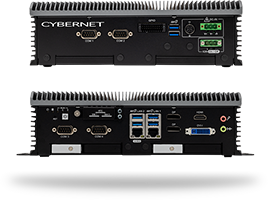Computers have many abilities, from the mundane, like surfing the Internet, to jaw-dropping, like healthcare computers capable of running nonstop 24/7 and rugged industrial tablets still working after being dropped. Despite this, users may need greater processing power or additional functions their current machine can't provide due to the lack of available hardware space or power.
The Peripheral Component Interconnect Express (PCIe) slot solves this limitation. It connects compatible peripherals like solid-state drives and expansion cards directly to the PC. Users can then expand their machine's capacity with additional data storage or give it new abilities, like running artificial intelligence (AI).
What is PCIe?
The PCIe or PCI Express slot is a standard expansion bus in virtually all modern (post-2012) computers. Found on the computer's motherboard, a PCIe provides a physical, high-speed input-output serial connection between the computer's central processing unit (CPU) and peripherals like the previously mentioned solid-state drive. Users simply plug the desired peripheral into the PCIe slot.
PCIe is different from Peripheral Component Interconnect (PCI), which can be found in many older computers. PCIe effectively replaces the older standard, and their hardware configurations are significantly different: you cannot insert a PCIe card into a PCI slot and vice versa.
Purpose of PCIe
PCIe allows faster communication between the CPU and PCIe-compatible peripherals, such as graphics cards and networking adapters. Compared to the older PCI standard, for example, PCIe provides:
- Greater bandwidth (up to 16 GB/s vs PCi's 533 MB/s)
- Faster data transmission speeds
- Improved power efficiency
PCIe slots and cards provide these advantages through their lanes or paths for data to travel. Lanes are described in x1, x2, x4, x8, and x16 configurations. The higher the number, the higher the potential data transfer rate (usually double the previous one). A PCIe x1 slot provides a single lane of data communication, while an x16 slot offers sixteen lanes of transfer.
Unlike PCI, PCIe slots and cards also support advanced technologies such as hot swapping, which allows the user to swap cards in and out of the computer without disrupting it.
PCIe has gone through several generations, each showing marked increases in data transfer rates, bandwidth, and features. The most current is PCIe 6.0, made available in 2022 and supports a maximum bandwidth of 128 gigabytes per second in a PCIe x16 slot, and can be found on everything ranging from medical panel computers to industrial rack mount PCs.
Common Applications Using PCIe Slots
How a PCIe slot is used depends on the peripheral inserted into it. Some common types of PCIe-compatible cards include:
- Capture Card
- Graphics Card
- M.2 NVMe Expansion Cards
- Network Interface Card (NIC)
- Riser Cards
- SATA Expansion Cards
- Sound Card
- Storage Controller Card
- USB Expansion Card
Many PCIe slots will accept different lane configurations. For example, you can insert a PCIe x1 card into a PCIe x16 slot or a PCIe x8 card into a PCIe x4 slot. There is no advantage, though, as bandwidth or data communication is limited to the lower lane. Thus, the PCIe x8 card in the x4 slot will only exchange half its data. It's usually best practice to match the peripheral's card and lane configuration to its matching PCIe slot.
Examples of PCIe slots and their uses include:
PCIe x1: This is the smallest PCIe slot with one lane for data transfer. Its typical applications include sound, network, and USB expansion cards.
PCIe x2: Similar to PCIe x1 but double the number of lanes for faster performance.
PCIe x4: This slot has four lanes for data transfer. It can be used for storage controllers, RAID cards, some SSD and SATA cards, and high-speed network adapters. Peripherals with PCIe x4 cards can also be inserted into an x16 slot.
PCIe x8: This configuration's eight data lanes are typically used for some network adapters and specialized data acquisition cards requiring high-performance data transfer rates. GPU and SSD cards with an x8 configuration can fit x16 slots but operate at only half-efficiency.
PCIe x16: This is the largest PCIe slot with 16 data lanes. It is used for high-end gaming, content creation, artificial intelligence, and workstation systems. The GPUs used for such applications would be placed in this slot.
Always have a PCIe Slot Open With Cybernet Manufacturing
Computers have many capacities, from processing graphics to connecting to the Internet. However, sometimes users want more, like increased processing power, to handle upcoming technologies like AI. PCIe slots provide such capabilities by connecting with expansion cards and compatible peripherals.
Contact the team at Cybernet Manufacturing if you're looking for computers with PCIe slots that are usable for your specific needs. Our healthcare, industrial, and enterprise PCs have been built to be easily expanded with new features and capabilities. If you still can't come up with a suitable configuration, our team members will happily work with you for even more custom options. Our company is an Original Equipment and Design Manufacturer, which gives us complete control over our products and services.
Join the conversation and connect with us on this and other relevant topics - Follow us on Facebook, Twitter, Instagram, LinkedIn, TikTok, and YouTube.


